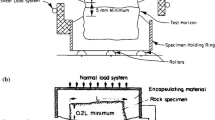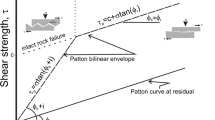Abstract
By conducting the direct shear test on a sample with a stepped structural plane and selecting representative samples for the cyclic shear test under fixed normal stress, the effects of the number (N) of the stepped structural plane, the top length (l1) of the stepped plane and the height (h) of the stepped structural plane on the shearing characteristics and damage morphologies of the specimens were studied. Test results show that: The shear strength of the stepped structural plane and the deterioration index of shear strength are affected by the stress concentration at the corners of the structural plane, the length of the rock bridge, the area and the aspect ratio of structural plane and the ability to resist edge failure of the specimen. When the value of l1 and h is fixed, as N raises from 1 to 5, the shear strength reaches the minimum value at N = 5. Shear failure is transformed into direct shear failure. In the specimen with single stepped structural plane, when the value of h is fixed, as l1 from 10 to 50 mm, the frictional sliding force between the crack surfaces will decrease firstly and then increases with the growth of number of diagonal crack. In the double stepped structural plane specimen, when the value of h is fixed, as l1 from 10 to 50 mm, the shear strength and c increases first then decreases. When the value of l1 is fixed, as h from 10 to 25 mm, the shear strength reaches the maximum value at h = 20 mm. The deterioration index of shear strength was inversely proportional to the number of cyclic shears, which is in turn proportional to N, h, and l1.




























Similar content being viewed by others
References
Asadi MS, Rasouli V, Barla G (2012) A bonded particle model simulation of shear strength and asperity degradation for rough rock fractures. Rock Mech Rock Eng 45:649–675
Bahaaddini M, Hagan PC, Mitra R, Khosravi MH (2013) Numerical direct shear tests to model the shear behaviour of rock joints . Comput Geotech 51:101–115
Bahaaddini M, Hagan PC, Mitra R, Khosravi MH (2016) Experimental and numerical study of asperity degradation in the direct shear test. Eng Geol 204:41–52
Cai-Chu X, Zhi-Cheng T, Wei-Min X, Ying-Long S (2014) New peak shear strength criterion of rock joints based on quantified surface description. Rock Mech Rock Eng 47:387–400
Fanzhen M, Hui Z, Zaiquan W, Chuanqing Z, Shaojun L, Liming Z, Liang K (2018) Characteristics of asperity damage and its influence on the shear behavior of granite joints . Rock Mech Rock Eng 51:429–449
Ghazvinian AH, Taghichian A, Mahmoud H, Mar’ashi SA (2010) The shear behavior of bedding planes of weakness between two different rock types with high strength difference. Rock Mech Rock Eng 43:69–87
Gu XF, Seidel JP, Haberfield CM (2003) Direct shear test of sandstone concrete joints. Int J Geomech 3(1):21–33
Huang JX, Shisheng SH (2014) Numerical investigations of the dynamic shear behavior of rough rock joints. Rock Mech Rock Eng 47:1727–1743
Hui Z, Fanzhen M, Zhang Chuanqing Hu, Dawei YF, Jingjing Lu (2015) Analysis of rockburst mechanisms induced by structural planes in deep tunnels . Bull Eng Geol Environ 74:1435–1451
Jafari MK, Amini HK, Pellet F, Boulon M, Buzzi O (2003) Evaluation of shear strength of rock joints subjected to cyclic loading. Soil Dyn Earthq Eng 23:619–630
Jahanian H, Sadaghiani MH (2015) Experimental study on the shear strength of sandy clay infilled regular rough rock joints. Rock Mech Rock Eng 48:907–922
Jie L, Chen Yu, Wen W, Jun W, Xiang F (2018) The influence of bedding plane orientation on rock breakages in biaxial states. Theoret Appl Fract Mech 95:186–193
Liren B, Chunsheng CL (2018) A direction-dependent shear strength criterion for rock joints with two new roughness parameters. Arab J Geosci 11:466
Mahdi NSM, Seshagiri Rao K, Shrivastava AK (2017) Effect of rock joint roughness on its cyclic shear behavior [J]. J Rock Mech Geotechn Eng 9:1071–1084
Mirzaghorbanali A, Nemcik J, Aziz N et al (2014) Effects of cyclic loading on the shear behaviour of infilled rock joints under constant normal stiffness conditions. Rock Mech Rock Eng 47(4):1373–1391
Sang-Woo L (2014) Influence of asperity characteristics on plane interface shear behavior. KSCE J Civil Eng 18(3):742–750
Sang-Woo L, Da-Woon J, Seong-Won L, Seok-Won L (2014) Influence of asperity characteristics on plane interface shear behavior. KSCE J Civil Eng 18(3):742–750
Tae-Hyuk K, Eun-Soo H, Gye-Chun C (2010) Shear Behavior of rectangular-shaped asperities in rock joints. KSCE J Civil Eng 14(3):323–332
Wenchen F, Ping C, Guodong T (2019) Experimental and numerical study on the damage evolution of random rock joint surface during direct shear under CNL condition . Geotech Geol Eng 37:975–983
Xiaobo Z, Qinghui J, Kulatilake PHSW, Feng X, Chi Y, Zhicheng T (2018) Influence of asperity morphology on failure characteristics and shear strength properties of rock joints under direct shear tests. Int J Geomech 19(2):04018196
Yanbing L, Sanjev D, Binyao H (2020) Coal and rock interface identification based on wavelet packet decomposition and fuzzy neural network . J Intell Fuzzy Syst 38:3949–3959
Yang ZY, Chang DY (2000) An experimental study on the progressive shear behavior of rock joints with tooth-shaped asperities. Int J Rock Mech Min Sci 37:1247–1259
Zhu JB, Li H, Deng JH (2018) A one-dimensional elastoplastic model for capturing the nonlinear shear behaviour of joints with triangular asperities based on direct shear tests. Rock Mech Rock Eng. https://doi.org/10.1007/s00603-018-1674-z
Acknowledgements
This work was supported by the Systematic Project of Guangxi Key Laboratory of Disaster Prevention and Engineering Safety (Grant No. 2019ZDK051), and the Open Research Fund of State Key Laboratory of Simulation and Regulation of Water Cycle in River Basin (China Institute of Water Resources and Hydropower Research, Grant NO. IWHR-SKL-201708).
Author information
Authors and Affiliations
Corresponding author
Additional information
Publisher's Note
Springer Nature remains neutral with regard to jurisdictional claims in published maps and institutional affiliations.
Rights and permissions
About this article
Cite this article
Hao, B., Xiong, L., Li, Y. et al. Cyclic Direct Shear Test on Rock Sample with Stepped Structural Plane. Geotech Geol Eng 39, 2373–2397 (2021). https://doi.org/10.1007/s10706-020-01633-7
Received:
Accepted:
Published:
Issue Date:
DOI: https://doi.org/10.1007/s10706-020-01633-7




